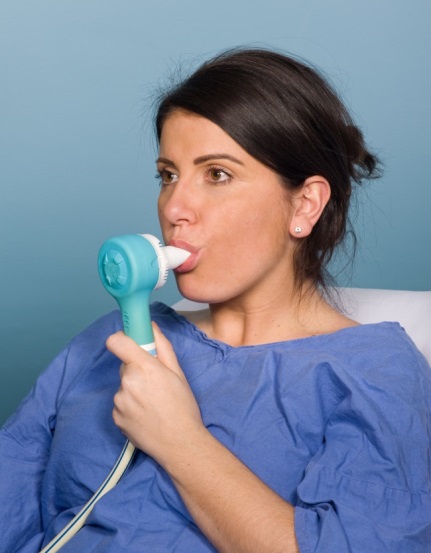- Reference Number: HEY-927/2020
- Departments: Anaesthetics
- Last Updated: 14 December 2020
This leaflet has been produced to give further information about your choice of pain relief medication during your procedure. Most of your questions should be answered by this leaflet. It is not meant to replace the discussion between you and the healthcare team but may act as a starting point for discussion. If after reading it you have any concerns or require further explanation, please discuss this with a member of the healthcare team.

Figure 1: Patient using Entonox demand valve. Image used with permission of Wiley and The Royal Marsden NHS Trust. Used previously in: Dougherty, L.; Lister, S. (2015) The Royal Marsden Manual of Clinical Nursing Procedures
What is Entonox?
Entonox is a well-established pain relieving gas mixture. It consists of two gases, 50% nitrous oxide and 50% oxygen and is more commonly known as gas and air. Entonox is used to control pain during some investigations and procedures.
How do I use Entonox?
Entonox is self-administered; this means that you have control when using the gas. A nurse who has undergone training will supervise you and remain with you during the procedure. Before the start of the procedure, your nurse will show you how to use the equipment correctly. The Entonox is breathed in using a mouthpiece, which is held between your teeth with your lips closed. You will be asked to breathe normally using the mouthpiece; you should breathe in through your mouth only.
As you continue to use the Entonox you may become light-headed or drowsy, the nurse will check if you are ready to start the procedure. The Entonox gas only works when you breathe it in; you will need to continue breathing the Entonox during the procedure. When you stop breathing the gas, the effects wear off very quickly.
When do I start using Entonox?
The nurse will advise you when to start using the Entonox and will supervise you during the procedure. The nurse will ask you to start using the Entonox for approximately two minutes before the start of the procedure. You should continue to use the Entonox throughout the procedure.
The Entonox will help to relieve your pain but may not remove it completely. The normal breathing required to use the Entonox will also help you to keep relaxed during the procedure. If the use of Entonox is unsatisfactory at any stage, alternative pain relief can be administered; just ask the nurse who is supervising you.
The nurse will advise you to stop breathing the Entonox when the procedure is completed. Any effects from the gas will wear off very quickly.
What are the benefits of using Entonox?
- You are in control
- The pain relieving effects are rapid
- There are no long lasting side effects
Are there any alternatives?
If you do not wish to use Entonox you can discuss alternative pain relief with a nurse or doctor.
Are there any side effects?
Entonox can make you feel drowsy and a little light-headed. Because Entonox is self-administered, it is very safe. If you become drowsy, you will be unable to hold the mouthpiece to your mouth. This prevents you from breathing in too much of the gas and the effects of the Entonox will wear off very quickly.
Other possible side effects include dizziness, nausea, disorientation and a dry mouth.
A tingling sensation, usually in the fingers can occur; this is often due to breathing too quickly. Your nurse will encourage you to slow your breathing to a normal rate if this happens.
All these sensations disappear rapidly after you stop using Entonox.
When should I not use Entonox?
Entonox should not be used if you have:
- Air trapped in a part of the body where its expansion may be dangerous, such as air lodged in an artery
- A collapsed lung
- Decompression sickness (the bends) or if you have been diving within 48 hours
- Lung disease for breathing difficulties such as emphysema
- Injuries to the face and jaw
- Head injuries
- Have a blockage in the bowel or severely bloated stomach
- Suspected or known increased pressure on the brain
- Recent surgery on your eyes or ears where injections of gas have been used
- Within one week of taking methotrexate for arthritis or cancer
- If you have a tracheostomy
- Had any recent alcohol or recreational drugs
How soon does the Entonox wear off?
Entonox works only when you breathe it in. Its effects wear off very quickly once you have stopped using it, normally within about a minute. However, you should rest for at least 15 minutes before you start to walk around again.
What should I expect after having Entonox?
When the procedure is over, you will be asked to rest on a trolley for at least
15 minutes. You must not walk around as you may feel unsteady and dizzy.
As a safety precaution, it is advisable not to drive or operate machinery for at least 30 minutes after using Entonox. Do not drive unless you feel you are safe to do so. You must not drive if any sedation or other intravenous pain relief has been administered to you in addition to the Entonox.
Additional information about Entonox can be found at:http://www.bochealthcare.co.uk

